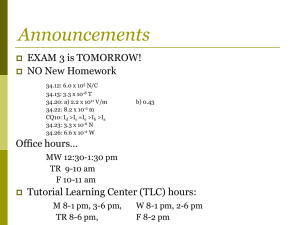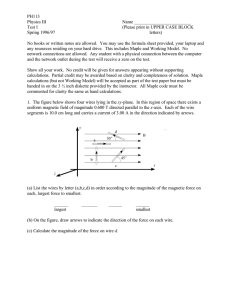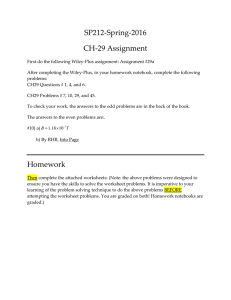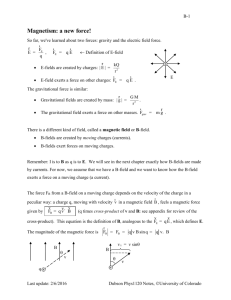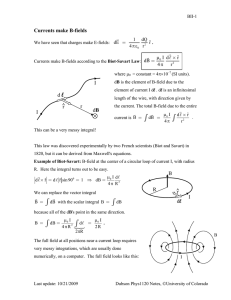Magnetism - University of Colorado Boulder
advertisement
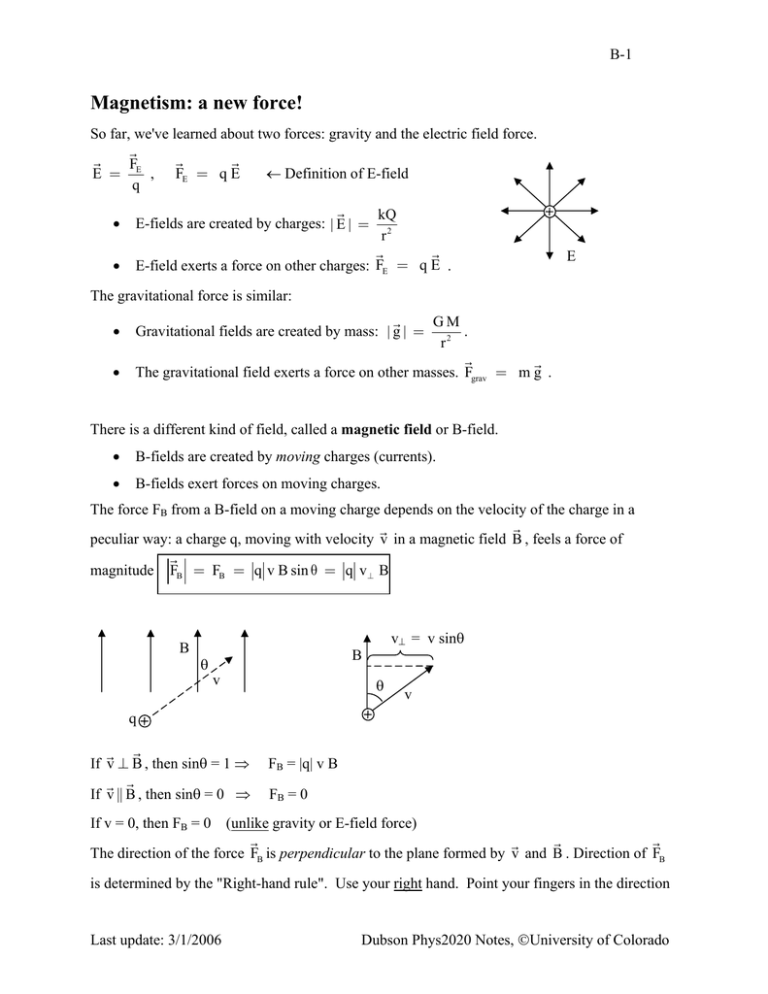
B-1 Magnetism: a new force! So far, we've learned about two forces: gravity and the electric field force. G G G G FE ← Definition of E-field E = , FE = q E q • • G kQ E-fields are created by charges: | E | = 2 r G G E-field exerts a force on other charges: FE = q E . E The gravitational force is similar: • • G GM Gravitational fields are created by mass: | g | = 2 . r G G The gravitational field exerts a force on other masses. Fgrav = m g . There is a different kind of field, called a magnetic field or B-field. • B-fields are created by moving charges (currents). • B-fields exert forces on moving charges. The force FB from a B-field on a moving charge depends on the velocity of the charge in a G G peculiar way: a charge q, moving with velocity v in a magnetic field B , feels a force of G magnitude FB = FB = q v B sin θ = q v⊥ B B v⊥ = v sinθ B θ v θ v q G G If v ⊥ B , then sinθ = 1 ⇒ G G If v & B , then sinθ = 0 ⇒ FB = |q| v B FB = 0 If v = 0, then FB = 0 (unlike gravity or E-field force) G G G G The direction of the force FB is perpendicular to the plane formed by v and B . Direction of FB is determined by the "Right-hand rule". Use your right hand. Point your fingers in the direction Last update: 3/1/2006 Dubson Phys2020 Notes, ©University of Colorado B-2 G G G of v , curl your fingers toward B . Thumb then points in the direction of FB if the charge q is G positive. (Orient hand so that fingers curl thru angle < 180o). If q is (-), FB is other way FB B v F (out) B q v Units of B: [B] = [B] = F (in) B q v B F (in) v q (–) [F] N = = 1 tesla (T) m [q][ v] C⋅ s Older, non-SI, unit of B: 1 gauss = 10-4 T , 1 T = 104 gauss • Earth's magnetic field ≈ 0.5 gauss = 5 × 10-5 T • kitchen magnet : 50 – 500 gauss = 0.005 – 0.05 T • iron core electromagnet: 2 T (max) (Strong enough to yank tools out of your hand.) • superconducting magnet: 20 T (max) Currents make B-fields You make a B-field with a current I. (Charges make E-fields, currents make B-fields). The B-field produced by a long straight wire, carrying current I, has magnitude B = µ0 I 2π r r = distance from wire, µo = constant = 4π×10-7 (SI units) (This formula can be derived from a fundamental law called Ampere's Law, which relates currents and B-fields .) Last update: 3/1/2006 Dubson Phys2020 Notes, ©University of Colorado B-3 B The direction of the B-field is perpendicular to I (out) B B the direction of the current. B r B The B-field lines form circles around the current, according to "Right-hand Rule II": Point thumb of RH along current I, I fingers curl along direction of B-field. A loop of wire carrying a current I forms a rather B complicated B-field: B-field lines are fundamentally different from E-field I lines in this way: E-field lines begin and end on charges (or go to ∞ ). But B-field lines always form closed loops with no beginning or end. It is possible to make a uniform, constant B-field with a solenoid = cylindrical coil of wire: B I End View: I I Side View Last update: 3/1/2006 B uniform inside Dubson Phys2020 Notes, ©University of Colorado B-4 Motion of a charged particle in magnetic field Consider a charge q moving in a uniform magnetic field B. Since the force FB is always G G perpendicular to the velocity v, the force FB does no work : FB ⊥ v ⇒ WFB = 0 . The magnetic force cannot change the KE or PE of the particle (since Work done = ∆KE + ∆PE). The B-field changes the direction of the velocity v, but does not change the speed. If the velocity v is perpendicular to the field B, the magnetic force bends the path of the particle in a circle. q v FB q FB v FB v B(out) uniform B (out) R FB v We can relate the radius R of the circular path to the magnitude of the field B and the speed v with Newton's Second Law: G G v2 Fnet = m a ⇒ q v B = m R Solving for R, we get R = G v2 ( recall that for circular motion a = ) R mv . Notice that the radius is proportional to the mass of the qB particle. In a mass-spectrometer, the mass of an unknown particle is determined from measurement of the radius (charge, speed and B-field are all known). The Velocity Selector The velocity selector is a device which measures the speed v of an ion. (ion = charged atom with one or more electrons missing) . A magnet produces a uniform B-field and a capacitor produces a uniform E-field, with E ⊥ B . Last update: 3/1/2006 Dubson Phys2020 Notes, ©University of Colorado B-5 Forces on charge: FB = q v B B(in) E v FE = q E mass m charge q uniform E down, B (in) The B and E fields are adjusted until the particle goes straight through. If the path is straight, then FB = FE ⇒ qvB = qE ⇒ v = E / B . Magnetic force on a current-carrying wire A B-field exerts a force on a moving charge. A current-carrying wire is full of moving charges, so a B-field exerts a force on the current-carrying wire. Recall that Fon q = q v⊥ B = q v Bsin θ . We will show below that this leads to Fon wire = I L B sin θ where I is the current, L is the length of the wire, and θ is the angle between the direction of B and the direction of the current. B (uniform) I L F = I L B ( B ⊥ I direction) F (in) Proof of Fon wire = I L B: Consider a section of wire, length L, carrying N moving charges. Assume B ⊥ wire. N moving charges B speed of moving charges = v = v current I = L Fon wire = N ⋅ Fon q = N q vN B = L t Last update: 3/1/2006 L t Nq t Nq L B = I L B (done) t N I Dubson Phys2020 Notes, ©University of Colorado B-6 Current-carrying wires exert magnetic forces on each other. Wire1 creates a B-field ( B = µ0 I ). Wire2 feels a force due to the B-field from wire A ( Fon wire = I L B ). 2π r Parallel currents attract, Anti-parallel currents repel. I1 I2 I1 I2 (Can you see why? Use Right hand rule.) F F F F r Permanent Magnets Currents make B-fields. So where's the current in a permanent magnet (like a compass needle)? An atom consists of an electron orbiting the nucleus. The electron is a moving charge, forming a tiny current loop –– an "atomic current". In most metals, the atomic currents of different atoms have random orientations, so there is no net current, no B-field. In ferromagnetic materials (Fe, Ni, Cr, some alloys containing these), the atomic currents can all line up to produce a large net current. In interior, atomic currents cancel: atoms on rim, currents all in same direction, currents add net I = 0 cross-section of magnetized iron bar In a magnetized iron bar, all the atomic currents are aligned, resulting in a large net current around the rim of the bar. The current iron bar then acts like a solenoid, producing a uniform Bfield inside: Last update: 3/1/2006 Dubson Phys2020 Notes, ©University of Colorado B-7 Side View: N uniform B(out) net atomic current on rim End View: B-field comes out of "North" end S atomic current on rim, like solenoid B-field enters "South" end Why do permanent magnets sometimes attract and sometimes repel? Because parallel currents attract and anti-parallel current repel. opposite poles attract : S N S parallel currents on ends attract N like poles repel : S N N S anti-parallel currents on ends repel Last update: 3/1/2006 Dubson Phys2020 Notes, ©University of Colorado B-8 Last update: 3/1/2006 Dubson Phys2020 Notes, ©University of Colorado
